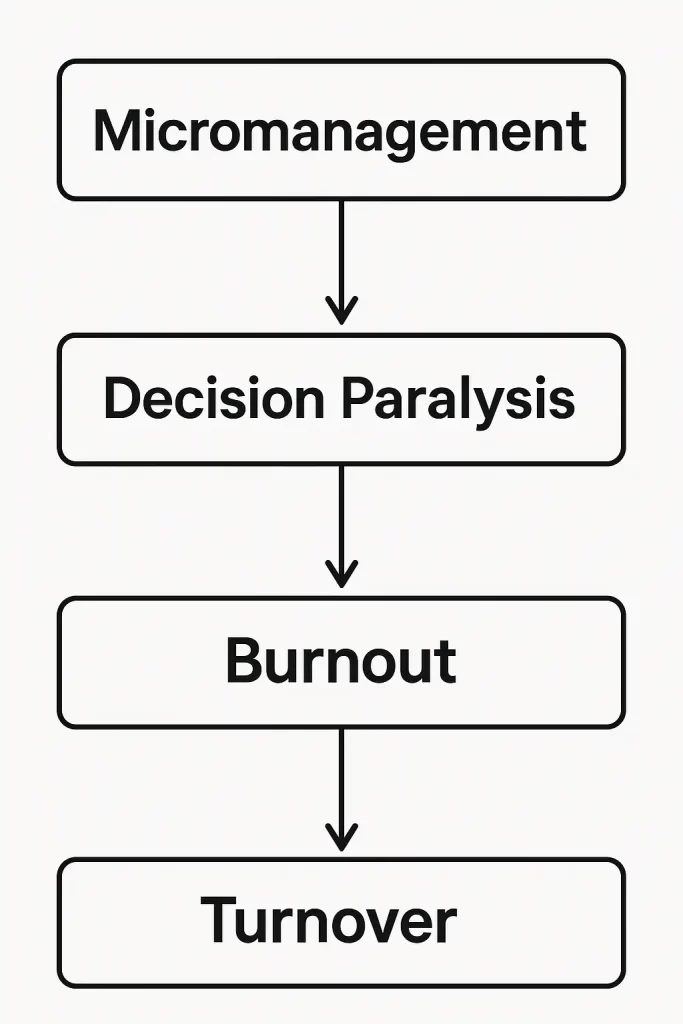
The Lie We Tell Ourselves as Leaders
Most managers will nod sagely when you talk about “autonomy.” They’ll quote Daniel Pink or throw around “Spotify squads” like candy at a TED talk. But behind closed doors?
They don’t actually want autonomous teams.
They want obedient soldiers dressed as creative thinkers. They want control with the illusion of freedom. It’s easier to say, “I empower my team” than to sit in the anxiety of not knowing what they’ll do next.
Here’s the truth:
If your team can’t make a decision without you, you’re not a leader. You’re a bottleneck.
“The best executive is the one who has sense enough to pick good people to do what he wants done, and self-restraint enough to keep from meddling with them while they do it.” – Theodore Roosevelt
Autonomy Isn’t a Perk – It’s the Whole Damn Point
Let’s stop sugarcoating it.
Autonomy isn’t a “nice to have.” It’s not a perk like gym membership or Donut Fridays. It’s the fundamental difference between:
- A team that builds products,
- And a team that builds trust.
And here’s the brutal part – autonomy exposes weakness. Not just in your team. In you.
When you fear autonomy, it says:
- “I don’t trust my team to make the right call.”
- “I secretly believe I’m the smartest person in the room.”
- “I don’t know how to fix things if they go wrong.”
In other words: I’m not leading. I’m managing my own fear.
Micromanagement Is a Cult of Control
Micromanagers aren’t evil. They’re scared.
But fear makes us hesitant. And teams can sense it.
- You rewrite their code “just to make it cleaner.”
- You hover in every sprint planning meeting “just to help.”
- You pull back decision-making “because it’s critical.”
You justify it to yourself as “maintaining quality.”
But what you’re really doing is training your team to stop thinking.
If you’re making all the decisions, here’s what you’re building:
- A team of yes-people
- A backlog of dependency
- A future where you are the single point of failure

Autonomy Without Competence Is a Suicide Pact
Let’s not pretend the opposite of micromanagement is a utopia.
Giving autonomy to an unskilled or misaligned team isn’t empowering – it’s neglect.
Autonomy without competence creates:
- Wandering priorities
- Narcissistic heroism
- Decision whiplash
- Unaccountable chaos
It’s not noble. It’s lazy. It’s abdication.
Your job as a leader is not to “let go.”
Your job is to prepare them to be let go of.
“Don’t give people autonomy until they’ve proven responsibility. Otherwise, you’re just letting toddlers drive your car.” – (Me)
Warning Signs You’re Faking Autonomy
If you’re doing any of the following, you’re pretending to offer autonomy – and your team knows it:
- You say “You own this,” but override decisions during reviews.
- You assign “accountability” but never ask how they’re solving things.
- You allow decisions only within pre-approved templates.
- You demand “innovation” but punish deviation.
That’s not autonomy. That’s theater.
Real autonomy means:
- They choose the tools – and own the consequences.
- They pick the architecture – and debug it when it burns.
- They challenge your idea – and you don’t flinch. You get curious.
The Real Test: Would They Still Thrive Without You?
Here’s your crucible:
If you took a 3-week vacation and turned off your phone, what would happen to your team?
- Would they freeze?
- Would they fight?
- Would they fly?
That tells you everything.
The most effective leaders are anti-fragile creators of leaders, not followers waiting for instructions. They don’t create dependency – they breed independence.
“The best leaders are those whose teams continue to thrive long after they’re gone.” – Liz Wiseman
But Wait – What About Accountability?

You might say:
“Autonomy sounds great until someone screws up. Then I get blamed.”
Yes. You will. Because you’re the leader.
But here’s the thing:
You’re already responsible. The only question is whether your team is strong enough to carry it with you.
The solution isn’t control. It’s clarity.
- Clear vision.
- Clear priorities.
- Clear boundaries.
And then? Get out of the way.
How to Actually Build Autonomy
Let’s get tactical. Here’s how to start today:
1. Set decision boundaries
Map out what the team can decide, what they should escalate, and where the overlap is. Make it visual. Revisit monthly.
2. Kill the “approval mindset”
Ban questions like “Is it okay if we…”
Replace with: “We plan to do X because of Y. Objections?”
3. Reward initiative, not compliance
Celebrate how people think – not just that they followed instructions.
4. Get brutally honest in retros
Ask: Where did you wait for permission? Where did I insert myself where I shouldn’t have?
5. Make leaving not a disaster
Train people to replace you. Make knowledge sharable. If you’re hit by a bus(or win the lottery), the team should keep running. If not – you failed.
Final Word: Autonomy Isn’t Comfortable – It’s Courageous
Stop pretending this is easy.
It takes guts to loosen your grip.
To watch your team fail.
To let them fix it.
But that is leadership.
“If you want to build a ship, don’t drum up the men to gather wood, divide the work, and give orders. Instead, teach them to yearn for the vast and endless sea.” – Antoine de Saint-Exupéry
Your Turn: Do This Today
Audit your own leadership:
- What decisions am I clinging to?
- Where am I being the bottleneck?
- Which team members are ready for more space – and which need more coaching?
Then do the hard thing: let go. Even a little.
Because in the end, the only thing scarier than giving your team autonomy…
…is never seeing what they’re truly capable of.
If this hit a nerve, these books dig deeper into the leadership truths we keep avoiding:
Drive – Daniel H. Pink
Turn the Ship Around! – L. David Marquet
Multipliers – Liz Wiseman
The Fearless Organization – Amy Edmondson
Team Topologies – Matthew Skelton and Manuel Pais